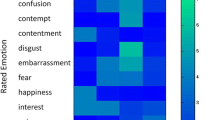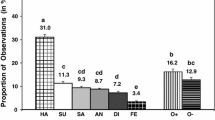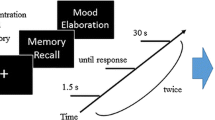Abstract
Twenty subjects judged 80 video segments containing brief episodes of smiling behavior for expression intensity and happiness of the stimulus person. The video records were produced under instructions to (a) pose, (b) experience a happy feeling or (c) to both experience and show a happy feeling. An analysis of the integrated facial electromyogram (EMG), recorded over four muscle regions (zygomaticus major, depressor anguli oris, corrugator supercilii, andmasseter), showed that judgments of happiness and of intensity of expression could be predicted in a multiple regression analysis (multipleR = .64 for perceived happiness and .79 for perceived expression intensity). The perception of happiness was affected by EMG activity in regions other thanzygomaticus major. The use of parameters other than the mean of the integrated EMG, namely variance, skewness, kurtosis and properties of the amplitude distributions across time, provided accurate classification of the elicitation conditions (pose happiness versus experience happiness) in a discriminant analysis. For the discrimination of posed and felt smiles variables describing aspects of facial activity in the temporal domain were more useful than any of the other measures. It is suggested that facial EMG can be a useful tool in the analysis of both the encoding and decoding of expressive behavior. The results indicate the advantage of using multiple-site EMG recordings as well as of using amplitude and temporal characteristics of the facial EMG measures.
Similar content being viewed by others
References
Buck, R. (1983). Nonverbal receiving ability. In J.M. Wiemann and R.P. Harrison (Eds.),Nonverbal interaction (pp.209–242). Beverly Hills, CA: Sage.
Cacioppo, J.T., Marshall-Goodell, B., & Dorfman, D.D. (1983). Skeletal muscle patterning: Topographical analysis of the integrated electromyogram.Psychophysiology, 20 269–283.
Cacioppo, J.T. & Tassinary, L.G. (1987). The relationship between EMG response and overt facial actions.Face Value, 1 2–3.
Ekman, P. (1978). Facial signs: Facts, fantasies, and possibilities. In T. Seboek (Ed.),Sight, sound, and sense (pp. 124–156). Bloomington: Indiana University Press.
Ekman, P. (1982). Methods for measuring facial action. In K.R. Scherer & P. Ekman (Eds.),Handbook of methods in nonverbal behavior research (pp. 45–135). Cambridge: Cambridge University Press.
Ekman, P. (1984). Expression and the nature of emotion. In K.R. Scherer and P. Ekman (Eds.),Approaches to emotion (pp. 319–343), Hillsdale, NJ: Lawrence Erlbaum Associates.
Ekman, P., & Fridlund, A.J. (1987). Assessment of facial behavior in affective disorders. In J.D. Maser (Ed.),Depression and expressive behavior (pp. 33–57). Hillsdale, NJ: Lawrence Erlbaum Associates.
Ekman, P, & Friesen, W.V. (1978).The Facial Action Coding System. Palo Alto: Consulting Psychologists Press.
Ekman, P., & Friesen, W.V. (1982). Felt, false and miserable smiles.Journal of Nonverbal Behavior, 6 238–252.
Ekman, P., Friesen, W.V., & O'Sullivan, M. (1988). Smiles when lying.Journal of Personality and Social Psychology, 54 414–420.
Fridlund, A.J. (1979). Contour-following integrator for the dynamic tracking of electromyographic signals.Psychophysiology, 16 491–493.
Fridlund, A.J. (1989). Evolution and facial action in reflex, social motive, and paralanguage. In P.K. Ackles, J.R. Jennings, & M.G. Coles (Eds.),Advances in psychophysiology (Vol. 4). Greenwich, CT: JAI Press.
Fridlund, A.J., & Cacioppo, J.T. (1986). Guidelines for human electromyographic research.Psychophysiology, 23 567–589.
Fridlund, A.J., & Izard, C.E. (1983). Electromyographic studies of facial expressions of emotions and patterns of emotion. In J.T. Caciopoo & R.E. Petty (Eds.),Social psychophysiology: A sourcebook (pp.243–286). New York: Guilford Press.
Fridlund, A.J., Schwartz, G.E., & Fowler, S.C. (1984). Pattern recognition of self-reported emotional state from multiple-site facial EMG activity during affective imagery.Psychophysiology, 21 622–637.
Hager, J.C. (1982). Asymmetries in facial expression. In P. Ekman (Ed.),Emotion in the human face 2nd ed. (pp. 318–352). New York: Cambridge University Press.
Hess, U., Kappas, A., McHugo, G.J., Lanzetta, J.T., & Kleck, R.E. (1989).Facial expression: Its modulating impact on self-generated affect. Manuscript submitted for publication.
Hess, U., Kappas, A., & Scherer, K.R. (1988). Multichannel communication of emotion: Synthetic signal production. In K.R. Scherer (Ed.),Facets of emotion: Recent research (pp. 161–182). Hillsdale, NJ: Lawrence Erlbaum Associates.
Kappas, A., McHugo, G.J., Lanzetta, J.T., & Hess, U. (1988). A new look at asymmetry of facial action: The use of EMG.Psychophysiology, 25 454 (Abstract).
Manstead, A.S.R. (1988). The role of facial movement in emotion. In H.L. Wagner (Ed.),Social psychophysiology: Theory and clinical applications (pp. 105–129), New York: John Wiley & Sons.
Matsumoto, D. (1987). The role of facial response in the experience of emotion: More methodological problems and a meta-analysis.Journal of Personality and Social Psychology, 52 769–774.
Rinn, W.E. (1984). The neuropsychology of facial expression: A review of the neurological and psychological mechanisms of producing facial expressions.Psychological Bulletin, 95 52–77.
Scherer, K.R. (1982). Methods of research on vocal communication: Paradigms and parameters. In K.R. Scherer and P. Ekman (Eds.),Handbook of methods in nonverbal behavior research (pp. 136–198). Cambridge: Cambridge University Press.
Weiss, F., Blum, G.S., & Gleberman, L. (1987). Anatomically based measurement of facial expressions in simulated versus hypnotically induced affect.Motivation and Emotion, 11 67–81.
Winton, W.M. (1986). The role of facial response in self-reports of emotion: A critique of Laird.Journal of Personality and Social Psychology, 50 808–812.
Author information
Authors and Affiliations
Additional information
The research was supported in part by funds associated with the John Sloan Dickey Third Century Professorship (Kleck) and in part by grant BNS-8507600 from the National Science Foundation (Lanzetta). Ursula Hess and Arvid Kappas were supported by stipends from the Deutscher Akademischer Austauschdienst (German Academic Exchange Service).
Rights and permissions
About this article
Cite this article
Hess, U., Kappas, A., McHugo, G.J. et al. An analysis of the encoding and decoding of spontaneous and posed smiles: The use of facial electromyography. J Nonverbal Behav 13, 121–137 (1989). https://doi.org/10.1007/BF00990794
Issue Date:
DOI: https://doi.org/10.1007/BF00990794




